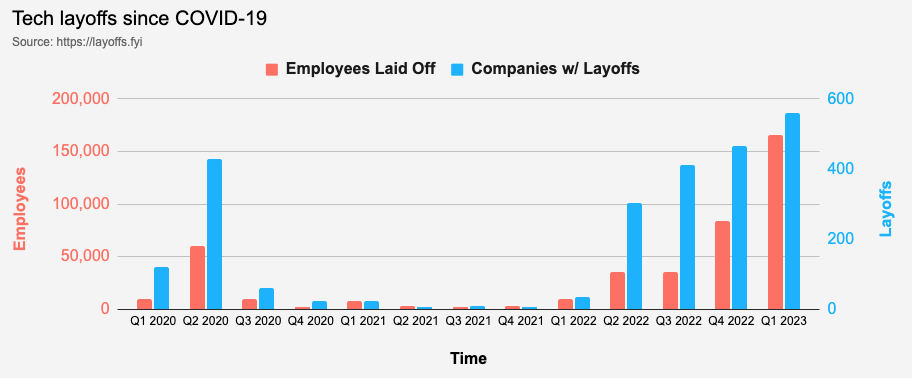Tech Layoffs Q1 Update
We focus on talent-based businesses, and the relative needs of different skills are important to us. On the tech side, we enjoy tracking the additions and reductions in talent demand.
For simplicity, we started to track the data from Layoffs.fyi (https://layoffs.fyi/), which summarizes announcements from companies regarding their tech talent layoffs.

Let's look at the data in quarterly intervals. We can see that Q1 2023 has shown the highest number of companies (561) announcing tech layoffs and the highest number of employees being affected (~165,000) since 2020 worldwide. The absolute numbers may not be as relevant as worldwide companies that have reduced their tech headcount but have not announced those efforts and will not be reflected in this data. We think that the directional nature of the data is more important, given this source has been following a similar process to gather this data for some years now.
The last six quarters show a worsening image of the number of companies and employees affected, with Q1 being the highest. However, if we look at the data every month, we may be able to arrive at a different perspective. Let's check the monthly chart below.

March 2023 has been the month with the lowest company layoff announcements in the last five months (115 companies announced) and the lowest number of employees affected during the quarter (~37,000). These layoffs seem to result from over-hiring initiatives after the pandemic, combined with a macroeconomic softness seen in some industries during the last two quarters. Please check our prior blog post, in which we discuss the increased cost of capital in the US and worldwide as different central banks increase rates due to higher inflation readings.
The picture does not look as grim when we see lower statistics of companies announcing layoffs and fewer employees being affected since January 2023. We acknowledge that it can take months from cost optimization announcements to their actual implementation and that personnel affected by these measures are probably still being communicated and looking for their next opportunities.
The unemployment rate in the US is approximately 3.6%, and tech unemployment is estimated at 2.2%, which seems below structural unemployment from whichever angle we look at it. There appears to continue to be a full employment picture in technology, with 2 out of 100 employed professionals looking for a job in the US.
Additionally, the technology industry, which employs most of the technology talent in the US, tends to react first to macro changes (i.e., increased cost of capital, etc.) and, therefore, kicked off this first batch of layoff announcements starting in Q2 2022. We could see other sectors of the economy reacting later to macro changes, but these sectors employ fewer technology professionals. As a side note, the average recession length in the US has been approximately ten months since WW2 (e.g., GFC was 18 months, and Covid only lasted two months). The NBER has not declared the US in a recession yet, and when this happens, it is typically done retroactively.
We continue to see a supply-demand imbalance in tech talent worldwide, especially in emerging technologies. Different sources put this gap in the millions of tech jobs that could go unfilled in the next decade.
At Alten Capital we focus on investments in talent-related industries, with technology services being a keen interest of ours. Please reach out to get to know more about us and explore how we can collaborate.